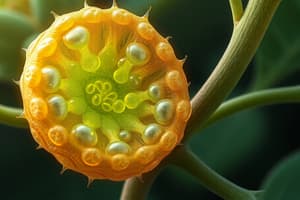Podcast
Questions and Answers
Which of the following characteristics is NOT a typical feature of plant cells?
Which of the following characteristics is NOT a typical feature of plant cells?
- Cell walls made of chitin for structural support. (correct)
- Plasmodesmata connecting adjacent cells.
- Large vacuoles for storage and turgor pressure maintenance.
- Presence of chloroplasts for photosynthesis.
The epidermis in plants is responsible for several functions. Which of the following is NOT a primary function of the epidermis?
The epidermis in plants is responsible for several functions. Which of the following is NOT a primary function of the epidermis?
- Facilitating gas exchange with the environment.
- Transporting water and nutrients throughout the plant. (correct)
- Controlling water loss through specialized structures.
- Protecting underlying tissues.
How does the periderm contribute to a plant's survival?
How does the periderm contribute to a plant's survival?
- By facilitating photosynthesis in older stems and roots.
- By actively transporting nutrients from the soil to the rest of the plant.
- By protecting the plant from pathogens, injury, and water loss. (correct)
- By producing the majority of ground tissue in woody plants.
Parenchyma cells are the most common type of cell in ground tissue. What is their primary function?
Parenchyma cells are the most common type of cell in ground tissue. What is their primary function?
What characteristics of collenchyma and sclerenchyma cells are responsible for providing strong, flexible structure to the plant?
What characteristics of collenchyma and sclerenchyma cells are responsible for providing strong, flexible structure to the plant?
How do tracheids and vessel elements in xylem contribute to the success of angiosperms?
How do tracheids and vessel elements in xylem contribute to the success of angiosperms?
During primary growth, apical meristems are responsible for increasing the height and length of plants. What is a key difference between root and shoot apical meristems?
During primary growth, apical meristems are responsible for increasing the height and length of plants. What is a key difference between root and shoot apical meristems?
During primary growth, new cells produced by apical meristems undergo several changes. What happens to these new cells?
During primary growth, new cells produced by apical meristems undergo several changes. What happens to these new cells?
Flashcards
Chloroplasts
Chloroplasts
Organelles in plant cells where photosynthesis occurs.
Cell Walls
Cell Walls
Provide structural support to plant cells.
Plasmodesmata
Plasmodesmata
Channels that connect adjacent plant cells, enabling communication and transport.
Dermal Tissue
Dermal Tissue
Signup and view all the flashcards
Epidermis (Plant)
Epidermis (Plant)
Signup and view all the flashcards
Ground Tissue
Ground Tissue
Signup and view all the flashcards
Vascular Tissue
Vascular Tissue
Signup and view all the flashcards
Xylem and Phloem
Xylem and Phloem
Signup and view all the flashcards
Study Notes
- BIO 102 Chapter 33 focuses on the plant body.
Plant Cells
- Plant cells contain chloroplasts for photosynthesis.
- Large vacuoles within plant cells maintain turgid pressure and store minerals and nutrients.
- Cell walls, composed of cellulose offer structural support to plant cells.
- Plasmodesmata connect adjacent plant cells.
Plant Tissues
- Three general types of plant tissues are dermal, ground and vascular.
Dermal Tissue
- Dermal tissue comprises the epidermis and periderm.
- The epidermis consists of closely packed cells that cover and protect underlying tissues, and controls water loss.
- Epidermal cells can secrete a cuticle, which is a waxy substance that protects against water loss and pathogens.
- Epidermal tissues can have hair-like structures, and stomata with guard cells to facilitate CO2/H2O exchange,.
- The periderm is a thick layer of dead cells that grows on the outside of stems and roots due to secondary growth and is part of the bark.
- The periderm protects the plant from pathogens, injury, and excessive water loss.
Ground Tissue
- Ground tissue makes up the majority of the plant.
- It is composed of parenchyma, collenchyma, and sclerenchyma cells.
- Parenchyma cells are the most common and perform photosynthesis to create sugars, and also store energy as starch.
- Collenchyma and sclerenchyma cells provide strong, flexible structure and have thick cell walls made of cellulose/lignin.
Vascular Tissue
- Xylem includes tracheids and vessel elements.
- The xylem cells have a wider diameter.
- Xylem transports materials faster, and allow for faster growth in angiosperms.
- Phloem's sieve tube cells are supported by companion cells in angiosperms, facilitating efficient nutrient transport.
Growth in Plants
- Primary growth results in plants growing upwards (shoot system; in the air) and downward (root system; underground).
- Primary growth is facilitated by apical meristems, with cells that continuously copy/reproduce.
- The root apical meristem has a cap to push through the soil to find water, and the new cells push downwards toward the cap.
- The shoot apical meristem lacks a cap, and produces new cells behind it for upward growth.
Secondary Growth
- Secondary growth is an outward growth where stems and roots get thicker over time, resulting in wooded growth.
- Secondary growth occurs due to the vascular cambium, a thin layer of cells between the xylem and phloem.
- Cells create new xylem to the interior, pushing the vascular cambium outwards.
- Cells also create new phloem to the exterior, pushing the old phloem outwards.
Studying That Suits You
Use AI to generate personalized quizzes and flashcards to suit your learning preferences.



